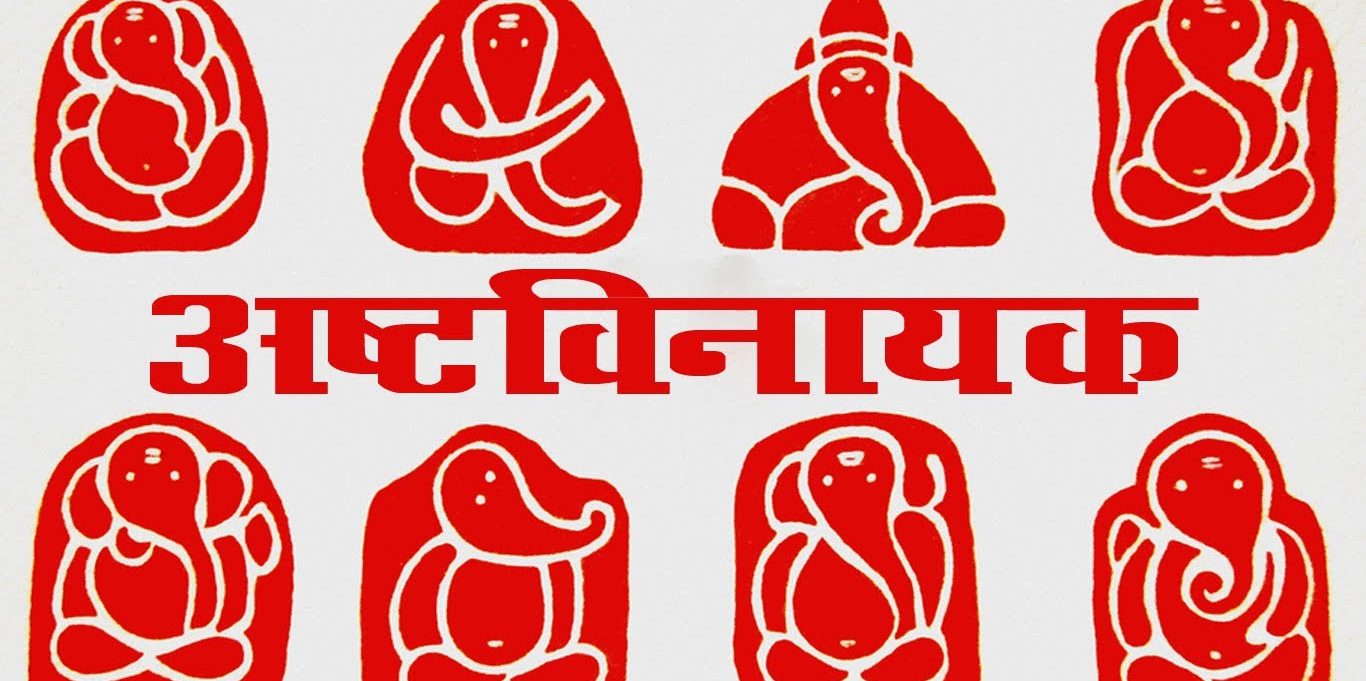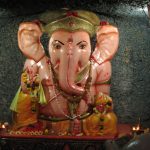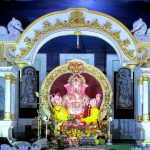1. BALLALESHWAR, PALI
In the Konkan Pallir village now known as Pali there lived a young boy Ballal who was a very sincere devotee of Lord Ganesh. Son of a rich businessman, his pre-occupation with worship at a young age displeased his father. Ballal spent a large part of his time in worship and influenced his friends to do so too. His friends’ parents felt that Ballal was misleading their children by showing them the Bhaktimarg [the path of devotion] at such young age. They asked Ballal’s father to restrain him. His father went to look for Ballal and found him in the forest engrossed in his worship of Lord Ganesh. He disrupted the puja, threw away the idol of Ganesh and beat his son. Not content with this he also tied him to a tree. He then left Ballal in the forest asserting that let Lord Ganesh himself come and rescue him. Ballal was in great pain but he kept calling upon Lord Ganesh who took the form of a Brahmin and appeared before him. He set Ballal free and then asked him to make a wish. Ballal entreated Lord Ganesh to reside in this region. The God acquiesced and resided in a stone which is now believed to be the idol of Ballaleshwar Vinayak which people worship at Pali. The idol that Ballal’s father had desecrated, was also placed in the temple. The idol of Dhundivinayak nearby is believed to be that idol.
2. CHINTAMANI, THEUR
Ganasura or Gana was the son of king Abhijit and his wife Gunavati. A strong, but greedy and hot-headed warrior king, Gana pleases Lord Shiva with his worship. Shiva grants Gana the kingship of the three worlds – heaven, earth and underworld and decreed that Gana could not be killed by anything that possessed any of the three gunas. Once, Gana arrives at the hermitage of the sage Kapila, who owned the wish-granting jewel Chintamani. Kapila serves the prince and his army with delicious food created with the help of the jewel. The greedy prince desires to acquire the jewel, but the sage refuses. However, Gana seizes it from the sage. Kapila, a devotee of Ganesha, prays to Ganesha to retrieve the gem. Ganesha with his army appears in Gana’s dream and beheads him. Gana wakes up and marches towards Kapila’s hermitage with his army, intending to slay the sage. Abhijit tries to dissuade his son and advises him to return Chintamani to the sage, but in vain. Gana starts to destroy the hermitage. Meanwhile, Ganesha’s shakti (“power”), takes the form of goddess Siddhi and creates a thousand-armed warrior Laksha, who destroys Gana’s army while Ganesha himself beheads the arrogant prince. Ganesha returns the jewel to Kapila, however, the sage chooses to have his Lord instead of the jewel itself.
3. GIRIJATMAJ, LENYADRI
It is believed that Parvati performed penance to beget Ganesha at this point. Girija’s (Parvati’s) Atmaj (son) is Girijatmaj. This temple stands amidst a cave complex of 18 caves of Buddhist origin. This temple is the 8th cave. These are called Ganesh-leni as well. The temple was carved out of a single stone hill and has 307 steps. The temple features a wide hall with no supporting pillars. The temple hall is 53 feet long, 51 feet wide and 7 feet in height. The idol faces north with its trunk to the left, and has to be worshipped from the rear of the temple. The temple faces south. This idol seems to be little different from the rest of the Ashtavinayak idols in a sense that it appears to be not very well designed or carved like the other idols. This idol can be worshipped by anyone. There is no electric bulb in the temple. The temple is constructed in such a way that during the day it is always lighted up by the sun-rays! On the Pune Nasik Road passing through Chakan, Rajgurunagar, Manchar, Narayangaon to Junnar one can reach Lenyadri. Junnar is the town closest to Lenyadri. Lenyadri is 5kms from Junnar. Pune and Talegaon are the two closest Railway Stations
4. MAHAGANPATI, RANJANGAON
The temple of Mahaganpati is very close to the centre of the town Ranjangaon. The temple was erected during the rule of the Peshwas. The temple was built by Sardar Kine. Peshwa Madhavrao had constructed the Garbhagriha, the sanctum to house the Swayambhoo statue. Shiva is believed to have worshipped Ganesha before fighting the demon Tripurasura here. The temple was built by Shiva where he worshipped Ganesha, and the town he set up was called Manipur which is now known as Ranjangaon. The temple is situated 50 km from Pune on the Pune-Ahmednagar highway in the village of Ranjangaon.
5. MORESHWAR, MORGAON
The idol of Lord Ganesha, riding a peacock, in the form of Mayureshwara is believed to have slain the demon Sindhurasur at this spot. The idol, with its trunk turned to the left, has a cobra (Nagaraj) poised over it protecting it. The idol also has two other idols of Siddhi (Capability) and Buddhi (Intelligence).The temple is situated at a distance of 56 km from Pune, next to the river Karha in the village of Moregaon. The village derives its name from the Marathi name of the bird peacock – also the national bird of India; there used to be a lot of peacocks in this village in the ancient times, and the village is also set out in the shape of a peacock.
6. VIGHNESHWAR, OZHAR
The Mudgala Purana, Skanda Purana and the Tamil Vinayaka Purana record- King Abhinandana performed a sacrifice in which he did not give any offering to the god-king Indra. The infuriated Indra ordered Kala (time/death) to destroy the sacrifice. Kala took the form of demon Vignasura (obstacle-demon) and created obstacles in the sacrifice and ruined it. The demon continued to created havoc in the universe, creating obstacles in the good deeds and sacrifices of sages and other beings. Hearing the prayers of the ascetics, Ganesha began to battle the demon. The demon soon realised that it was impossible to win and surrendered to Lord Ganesha and agreed not to harass the beings of the world. It was arranged that Vignasura would dwell only in places where Ganesha was not invoked or worshipped. Vignasura also requested Ganesha to take the name Vigneshwara (The lord of Vigna/obstacles) to commemorate this event. The relieved sages consecrated an image of Ganesha as Vigneshwara at Ozar to mark the event.
7. VARADVINAYAK, MAHAD
The Varadvinayak temple is located in Mahad village of Khalapur taluka near Karjat and Khopoli of Raigad district. The temple was re-built by Peshwa General Ramji Mahadev Biwalkar in 1725 AD. Found in the adjoining lake in an immersed position in 1690 AD, it is said that the idol of this temple Varadavinayak is a swayambu (self-originated). There is an oil lamp in the temple which is said to be burning continuously since 1892. This temple also has the idol of Mushika, Navagraha Devtas and Shivalinga. There are four elephant idols guarding the four sides of the temple. Devotees visit the Varadvinayak temple throughout the year. During festivals like the Magha Chaturthi huge crowds can be seen in this temple.
8. SIDDHIVINAYAK, SIDDHTEK
The Hindu god Vishnu is supposed to have vanquished the demons Madhu and Kaitabh after propitiating Ganesh here. This is the only idol with the trunk pointing to the right. It is believed that the two saints- Shri Morya Gosavi and Shri Narayan Maharaj of Kedgaon received their enlightenment here. This temple is situated off the Pune-Solapur highway about 48 km from the town of Srigonda in Ahmadnagar district. The temple is situated next to river Bhima. On Pune-Solapur railway, Daund Railway station is 18Km from here.



























